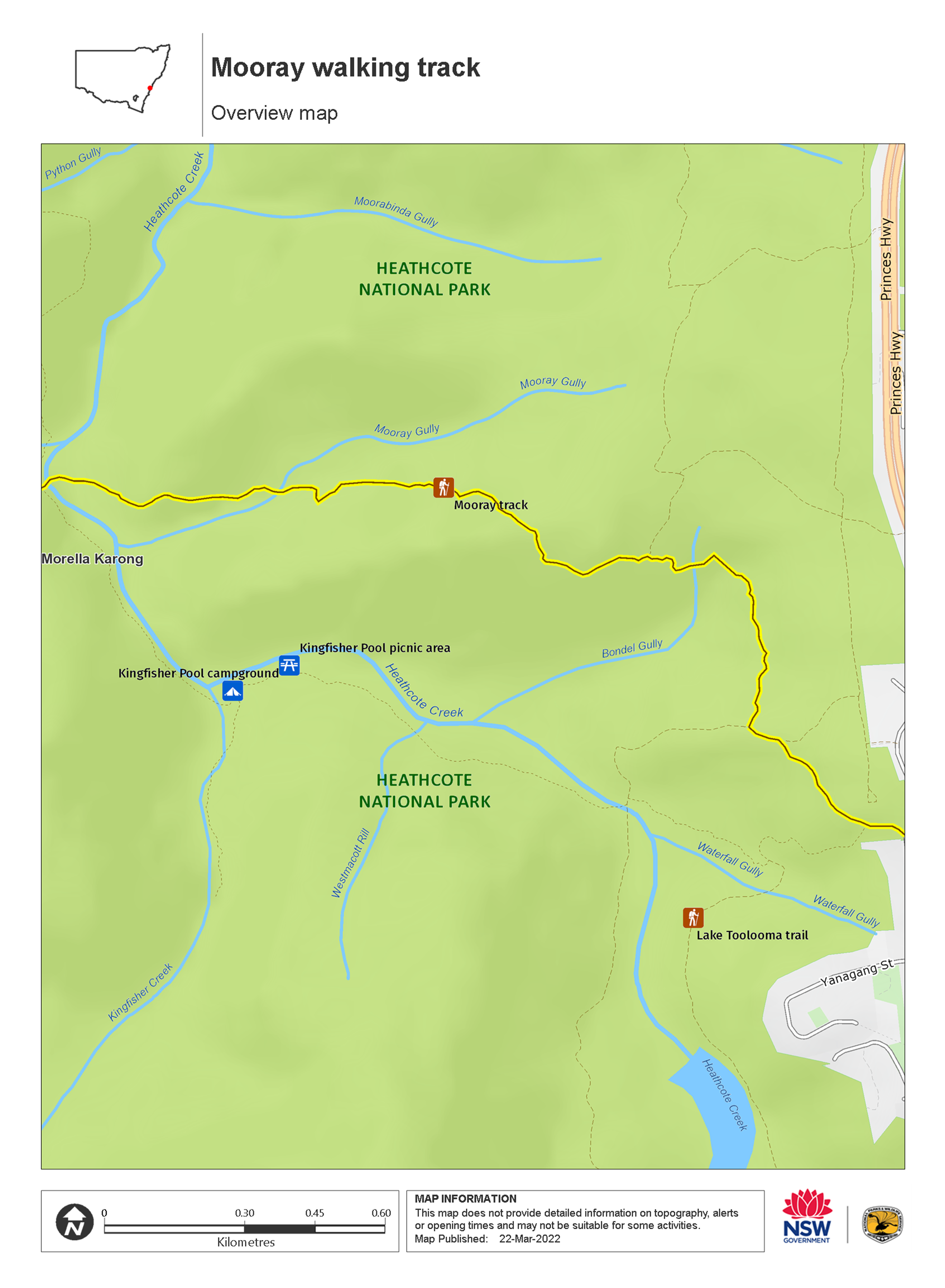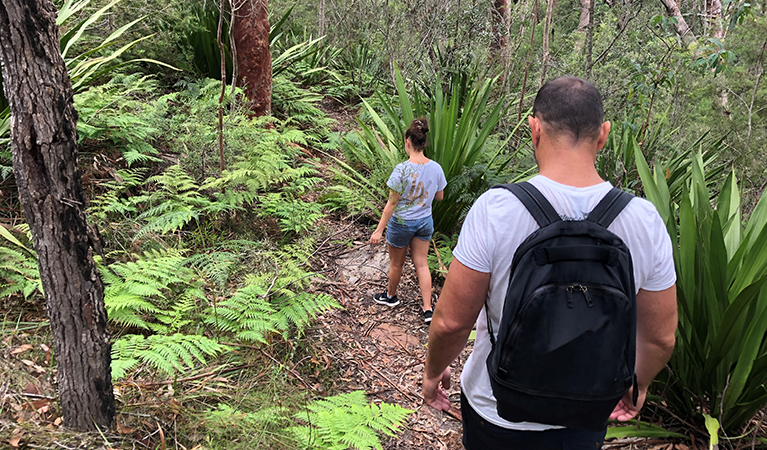Mooray walking track
Heathcote National Park
Overview
Enjoy a day of Sydney bushwalking and birdwatching. One of the best walks in Heathcote National Park, Mooray walking track is easily accessed from Waterfall train station.
- Distance
- 5km return
- Time suggested
- 3 - 4hrs
- Grade
- Grade 4
- Trip Intention Form
-
It's a good idea to let someone know where you're going. Fill in a trip intention form to send important details about your trip to your emergency contact.
- What to
bring - Hat, sunscreen, drinking water
Discover south-west Sydney’s diverse natural landscapes on this wonderful bushwalk, near Waterfall. Mooray walking track is a moderate half-day hike ideal for experienced bushwalkers, with sweeping heathland views across Heathcote National Park.
A favourite among birdwatchers, this signposted track starts via Warrabin Street trail, winding through at times tough terrain, yet rewarding you with glimpses of kingfishers and honeyeaters along the way. You could try to time your walk to coincide with the spring wildflower season; when the banksia, grevillea and hakea erupt with vibrant colours and scent.
Arriving at the end of the track at Heathcote Creek, choose to retrace your steps or head south along Bullawarring walking track and walk back via Kingfisher Pool picnic area for a refreshing swim. Why not make a weekend of it and pitch your tent at Kingfisher Pool campground?
Also see
-

Bullawarring walking track
For great Sydney bushwalking, visit Heathcote National Park, near Waterfall in the Sutherland shire; combine your hike with birdwatching and freshwater swimming.
Map

Map legend

Local alerts
For the latest updates on fires, closures and other alerts in this area, see https://www.nationalparks.nsw.gov.au/things-to-do/walking-tracks/mooray-walking-track/local-alerts
General enquiries
- National Parks Contact Centre
- 7am to 7pm daily
- 1300 072 757 (13000 PARKS) for the cost of a local call within Australia excluding mobiles
- parks.info@environment.nsw.gov.au
Park info
- in Heathcote National Park in the Sydney and surrounds and South Coast regions
Heathcote National Park is open sunrise to sunset but may have to close at times due to poor weather or fire danger.
Visitor info
All the practical information you need to know about Mooray walking track.
Maps and downloads
Learn more
Mooray walking track is in Heathcote National Park. Here are just some of the reasons why this park is special:
A long and varied history

The area was for years home to local Aboriginal people, and you can still see several Aboriginal rock engraving sites. In 1937, a bushwalking group leased a section of what is now national parkland to protect this important area of bush. This section and its surrounds became known as the Heathcote Primitive Area (1943). This was expanded again and renamed Heathcote State Park (1967). In 1974, the area became Heathcote National Park.
The beauty of the bush

Heathcote National Park is a rugged landscape, flourishing with a variety of plants and animals. Eucalypts such as bloodwood, grey gum, Sydney peppermint, and scribbly gum dominate open forest areas alongside pockets of bright flowers like banksias, hakeas, and waxflowers, which are best enjoyed along a relaxing bushwalk. With so much plant life to admire, it’s no wonder wildlife like sugar gliders, ringtail possums and swamp wallabies also call Heathcote home. A soundtrack of chatty friar birds, honeyeaters and lyrebirds can also be heard across the park gorges during winter.
- Bullawarring walking track For great Sydney bushwalking, visit Heathcote National Park, near Waterfall in the Sutherland shire; combine your hike with birdwatching and freshwater swimming.
The great outdoors

Slow down and forget your cares with a freshwater swim. Try Kingfisher Pool, Mirang Pool or Lake Eckersley. Or check out the pretty rockpools and waterfalls where Heathcote Creek meets the Woronora River. Cycle along Pipeline Road to the Sarahs Knob picnic area, where you can also complete a great hill run. The 2250ha park is less than an hour from central Sydney by car or train. The park adjoins Royal National Park, just west of the Princes Highway and South Coast train line. However, once you're inside you'll forget about transportation - the park is beautiful, quiet and secluded, plus, it's a vehicle-free zone. If you love to bushwalk, then Heathcote is your kind of park. A multitude of walking tracks criss-cross the park, including the Heathcote to Waterfall track linking Heathcote and Waterfall train stations.
- Kingfisher Pool picnic area A visit to this Sutherland picnic spot, located at Kingfisher Pool campground in Heathcote National Park, near Waterfall, offers birdwatching, bushwalking and swimming.
- Mooray walking track Enjoy a day of Sydney bushwalking and birdwatching. One of the best walks in Heathcote National Park, Mooray walking track is easily accessed from Waterfall train station.
Plants and animals protected in this park
Animals
-

Eastern blue-tongue lizard (Tiliqua scinciodes)
The eastern blue-tongue lizard, one of the largest skinks in Australia, is found throughout most of NSW. When threatened, the eastern blue-tongue lizard displays its blue tongue in a wide-mouthed intimidating show. Not an agile animal, they feed on slow-moving beetles and snails.
-

Yellow-tailed black cockatoo (Calyptorhynchus funereus)
The yellow-tailed black cockatoo is one of the largest species of parrot. With dusty-black plumage, they have a yellow tail and cheek patch. They’re easily spotted while bird watching, as they feed on seeds in native forests and pine plantations.
-

Koala (Phascolarctos cinereus)
One of the most renowned Australian animals, the tree-dwelling marsupial koala can be found in gum tree forests and woodlands across eastern NSW, Victoria and Queensland, as well as in isolated regions in South Australia. With a vice-like grip, this perhaps most iconic but endangered Australian animal lives in tall eucalypts within a home range of several hectares.
Plants
-

Grass tree (Xanthorrea spp.)
An iconic part of the Australian landscape, the grass tree is widespread across eastern NSW. These Australian native plants have a thick fire-blackened trunk and long spiked leaves. They are found in heath and open forests across eastern NSW. The grass tree grows 1-5m in height and produces striking white-flowered spikes which grow up to 1m long.
-

Old man banksia (Banksia serrata)
Hardy Australian native plants, old man banksias can be found along the coast, and in the dry sclerophyll forests and sandstone mountain ranges of NSW. With roughened bark and gnarled limbs, they produce a distinctive cylindrical yellow-green banksia flower which blossoms from summer to early autumn.
-

Scribbly gum (Eucalyptus haemastoma)
Easily identifiable Australian native plants, scribbly gum trees are found throughout NSW coastal plains and hills in the Sydney region. The most distinctive features of this eucalypt are the ‘scribbles’ made by moth larva as it tunnels between the layers of bark.

